Determination of the Red Mud Industrial Cluster Sites in Indonesia Based on Sustainability Aspect and Waste Management Analysis through PROMETHEE
Abstract
:1. Introduction
2. Materials and Methods
2.1. Study Area
2.2. Source of Research Data
- The map (Figure 1) showed the difficulty in locating a deepwater port in the Sukadana Bay area because New Panamax ships need 16 m of draft.
- The Sadai industrial estate (Figure 1) is relatively attractive. It appears to be integrated with Pangkalbalam ports.
- Regional government scheme promotes Teluk Batang as an alumina pilot plant site, but a forestry permit is required. Karimata Island, a 141 km bauxite haul from Teluk Batang, is unacceptable because of a strongly protected nature reserve (Figure 1).
- Antam and several alumina refinery pilot plants use the PT Pelindo II Mempawah port to export alumina from the port and import bauxite (Figure 1).
- Ketapang industrial estate is integrated with a 7 km jetty to the deepwater anchorage. The site is located near Rahadi Oesman airport and International Supadio airport.
2.3. Research Stage
2.4. Technique Analysis and Criteria Determination
- If π (a, b) = 0, there is no difference between a and b or no preferences for a over b.
- If π (a, b) ~ 0, the weak preference of a is better than b’s.
- If π (a, b) ~ 1, the strong preference of a is superior to b.
- π (a, b) = 1 indicates that the absolute preference of a is superior to b.
3. Results
4. Discussion
5. Conclusions
- PROMETHEE shows that the best pilot plant site is Ketapang.
- Ranking PROMETHEE, PROMETHEE Rainbow, PROMETHEE GAIA, and PROMETHEE V emerge as reliable predictors for determining red mud pilot plant sites.
Author Contributions
Funding
Institutional Review Board Statement
Informed Consent Statement
Acknowledgments
Conflicts of Interest
References
- Kaniki, A.T.; Tumba, K. Management of Mineral Processing Tailings and Metallurgical Slags of the Congolese Copperbelt: Environmental Stakes and Perspectives. J. Clean. Prod. 2019, 210, 1406–1413. [Google Scholar] [CrossRef]
- Mikula, K.; Izydorczyk, G.; Skrzypczak, D.; Moustakas, K.; Witek-Krowiak, A.; Chojnacka, K. Value-Added Strategies for the Sustainable Handling, Disposal, or Value-Added Use of Copper Smelter and Refinery Wastes. J. Hazard. Mater. 2021, 403, 123602. [Google Scholar] [CrossRef]
- Tsesmelis, K. Bauxite Mine Rehabilitation and Bauxite Residue Management: A Global Perspective. In Travaux 46, Proceedings of 35th International ICSOBA Conference, Hamburg, Germany, 2–5 October 2017; ICSOBA: Hamburg, Germany, 2017; Volume 42, p. 71. [Google Scholar]
- Paramguru, R.K.; Rath, P.C.; Misra, V.N. Mineral Processing and Extractive Metallurgy Review: An International Journal. Trends Red Mud Utilization 2004, 26, 1–19. [Google Scholar] [CrossRef]
- Damayanti, R.; Khareunissa, H. Composition and Characteristics of Red Mud: A Case Study on Tayan Bauxite Residue from Alumina Processing Plant at West Kalimantan. Indones. Min. J. 2017, 19, 179–190. [Google Scholar] [CrossRef] [Green Version]
- Narayanan, R.P.; Ma, L.C.; Kazantzis, N.K.; Emmert, M.H. Cost Analysis as a Tool for the Development of Sc Recovery Processes from Bauxite Residue (Red Mud). ACS Sustain. Chem. Eng. 2018, 6, 5333–5341. [Google Scholar] [CrossRef]
- Rai, S.; Bahadure, S.; Chaddha, M.J.; Agnihotri, A. Disposal Practices and Utilization of Red Mud (Bauxite Residue): A Review in Indian Context and Abroad. J. Sustain. Metall. 2020, 6, 1–8. [Google Scholar] [CrossRef]
- The European Commision. Commision Decisions 2014/955/EU-List of Waste. 2014. Available online: Https://Eur-Lex.Europa.Eu/Legal-Content/EN/TXT/PDF/?Uri=CELEX:32014D0955 (accessed on 18 July 2022).
- Mymrin, V.; Aibuldinov, E.K.; Alekseev, K.; Avanci, M.A.; Rolim, P.H.B.; Catai, R.E.; Carvalho, K.Q. Sustainable Material Manufacturing from Hazardous Bauxite Red Mud in Composites with Clay Slate Waste and Lime Production Waste. Int. J. Adv. Manuf. Technol. 2020, 111, 1375–1385. [Google Scholar] [CrossRef]
- Balomenos, E.; Davris, P.; Panias, D. Bauxite Residue Handling Practice and Valorisation Research in Aluminium of Greece. In Proceedings of the 2nd International Bauxite Residue Valorisation and Best Practices Conference, Athens, Greece, 7–10 May 2018; pp. 29–37. [Google Scholar]
- Swain, B.; Akcil, A.; Lee, J.C. Red Mud Valorization an Industrial Waste Circular Economy Challenge; Review over Processes and Their Chemistry. Crit. Rev. Environ. Sci. Technol. 2020, 52, 520–570. [Google Scholar] [CrossRef]
- Sharma, P.; Phanden, R.K. Analysis of Site Selection Based on Factors Rating. Int. J. Emerg. Trends Eng. Dev. 2017, 6, 616–621. [Google Scholar]
- Sipayung, A.J.; Suryaningtyas, D.T.; Sumawinata, B. Electrokinetic of Red Mud. In IOP Conference Series: Earth and Environmental Science; IOP Publishing: Bristol, UK, 2019; Volume 393, pp. 1–6. [Google Scholar]
- Vagiona, D.G. Comparative Multicriteria Analysis Methods for Ranking Sites for Solar Farm Deployment: A Case Study in Greece. Energies 2021, 14, 8371. [Google Scholar] [CrossRef]
- Ukpanyang, D.; Terrados-Cepeda, J.; Hermoso-Orzaez, M.J. Multi-Criteria Selection of Waste-to-Energy Technologies for Slum/Informal Settlements Using the PROMETHEE Technique: A Case Study of the Greater Karu Urban Area in Nigeria. Energies 2022, 15, 3481. [Google Scholar] [CrossRef]
- Izadikhah, M.; Saen, R.F. A New Preference Voting Method for Sustainable Location Planning Using Geographic Information System and Data Envelopment Analysis. J. Clean. Prod. 2016, 137, 1347–1367. [Google Scholar] [CrossRef]
- Ramya, S.; Devadas, V. Integration of GIS, AHP and TOPSIS in Evaluating Suitable Locations for Industrial Development: A Case of Tehri Garhwal District, Uttarakhand, India. J. Clean. Prod. 2019, 238, 117872. [Google Scholar] [CrossRef]
- Kaya, A.; Çiçekalan, B.; Çebi, F. Location Selection for WEEE Recycling Plant by Using Pythagorean Fuzzy AHP. J. Intell. Fuzzy Syst. 2020, 38, 1097–1106. [Google Scholar] [CrossRef]
- Ghoseiri, K.; Lessan, J. Waste Disposal Site Selection Using an Analytic Hierarchal Pairwise Comparison and ELECTRE Approaches under Fuzzy Environment. J. Intell. Fuzzy Syst. 2014, 26, 693–704. [Google Scholar] [CrossRef]
- Mousavi, S.M.; Tavakkoli-Moghaddam, R.; Heydar, M.; Ebrahimnejad, S. Multicriteria Decision Making for Plant Location Selection: An Integrated Delphi-AHP-PROMETHEE Methodology. Arab. J. Sci. Eng. 2013, 38, 1255–1268. [Google Scholar] [CrossRef]
- Wu, Y.; Wang, J.; Hu, Y.; Ke, Y.; Li, L. An Extended TODIM-PROMETHEE Method for Waste-to-Energy Plant Site Selection Based on Sustainability Perspective. Energy 2018, 156, 1–16. [Google Scholar] [CrossRef]
- Wu, Y.; Zhang, B.; Wu, C.; Zhang, T.; Liu, F. Optimal Site Selection for Parabolic Trough Concentrating Solar Power Plant Using Extended PROMETHEE Method: A Case in China. Renew. Energy 2019, 143, 1910–1927. [Google Scholar] [CrossRef]
- Vavatsikos, A.P.; Demesouka, O.E.; Anagnostopoulos, K.P. GIS-Based Suitability Analysis Using Fuzzy PROMETHEE. J. Environ. Plan. Manag. 2020, 63, 604–628. [Google Scholar] [CrossRef]
- Farkaš, B.; Hrastov, A. Multi-Criteria Analysis for the Selection of the Optimal Mining Design Solution—A Case Study on Quarry “Tambura”. Energies 2021, 14, 3200. [Google Scholar] [CrossRef]
- Batubara, M.; Purwanto, W.W.; Fauzi, A. Proposing a Decision-Making Process for the Development of Sustainable Oil and Gas Resources Using the Petroleum Fund: A Case Study of the East Natuna Gas Field. Resour. Policy 2016, 49, 372–384. [Google Scholar] [CrossRef]
- Nzotcha, U.; Kenfack, J.; Blanche Manjia, M. Integrated Multi-Criteria Decision Making Methodology for Pumped Hydro-Energy Storage Plant Site Selection from a Sustainable Development Perspective with an Application. Renew. Sustain. Energy Rev. 2019, 112, 930–947. [Google Scholar] [CrossRef]
- Zhang, J.; Xu, C.; Song, Z.; Huang, Y.; Wu, Y. Decision Framework for Ocean Thermal Energy Plant Site Selection from a Sustainability Perspective: The Case of China. J. Clean. Prod. 2019, 225, 771–784. [Google Scholar] [CrossRef]
- Singh, A.; Gupta, A.; Mehra, A. Best Criteria Selection Based PROMETHEE II Method. Opsearch 2021, 58, 160–180. [Google Scholar] [CrossRef]
- Daugavietis, J.E.; Soloha, R.; Dace, E.; Ziemele, J. A Comparison of Multi-Criteria Decision Analysis Methods for Sustainability Assessment of District Heating Systems. Energies 2022, 15, 2411. [Google Scholar] [CrossRef]
- Hendrik; Akhmad, F.; Widiatmaka; Suryaningtyas, D.; Firdiyono, F. Qualitative Data Envelopment Assessment of Different Alumina Refinery Plants: The Case of Bauxite Mining in West Kalimantan Province. In IOP Conference Series: Earth and Environmental Sciences; IOP Publishing: Bristol, UK, 2022; Volume 950, pp. 1–9. [Google Scholar]
- Brans, J.P.; Vincke, P.; Mareschal, B. How to Select and How to Rank Projects: The PROMETHEE Method. Eur. J. Oper. Res. 1986, 24, 228–238. [Google Scholar] [CrossRef]
- Durdevic, D.; Zikovic, S.; Blecich, P. Sustainable Sewage Sludge Management Technologies Selection Based on Techno-Economic-Environmental Criteria: Case Study of Croatia. Energies 2022, 15, 3941. [Google Scholar] [CrossRef]
- Vinodh, S.; Jeya Girubha, R. PROMETHEE Based Sustainable Concept Selection. Appl. Math. Model. 2012, 36, 5301–5308. [Google Scholar] [CrossRef]
- Kabir, G.; Sumi, R.S. Power Substation Location Selection Using Fuzzy Analytic Hierarchy Process and PROMETHEE: A Case Study from Bangladesh. Energy 2014, 72, 717–730. [Google Scholar] [CrossRef]
- Brans, J.P.; Mareschal, B. PROMETHEE Methods. In Multiple Criteria Decision Analysis; Springer: Berlin/Heidelberg, Germany, 2016; Volume 233, pp. 187–219. [Google Scholar]
- Yusuf, Y.; Florentinus, F.; Jamali, A.; Sabikun, S.; Napitulu, E.; Subagja, R.; Cahyono, E.D.; Nasution, R.; Kamaryanto, K.; Haryono, A.; et al. Feasibility Study on A Copper Cathode Plant Prepared for the Directorate General of Basic Metal Industry the Ministry of Industry Republic of Indonesia; National Institute for Metallurgy, Indonesian Institute of Sciences: Serpong, Indonesia, 1981. [Google Scholar]
- Elevli, B.; Ozturk, H. Multi-Criteria Assessment of Heavy Metals Contaminations in Waters and Ranking the Sites by Using PROMETHEE/GAIA Method. J. Environ. Health Sci. Eng. 2019, 17, 75–84. [Google Scholar] [CrossRef]
- Schröder, T.; Lauven, L.P.; Beyer, B.; Lerche, N.; Geldermann, J. Using PROMETHEE to Assess Bioenergy Pathways. Cent. Eur. J. Oper. Res. 2019, 27, 287–309. [Google Scholar] [CrossRef]
- Demircioǧlu, M.E.; Ulukan, H.Z. A Novel Hybrid Approach Based on Intuitionistic Fuzzy Multi Criteria Group-Decision Making for Environmental Pollution Problem. J. Intell. Fuzzy Syst. 2020, 38, 1013–1025. [Google Scholar] [CrossRef]
- Bagherikahvarin, M.; De Smet, Y. A Ranking Method Based on DEA and PROMETHEE II (a Rank Based on DEA & PR.II). Meas. J. Int. Meas. Confed. 2016, 89, 333–342. [Google Scholar] [CrossRef]
- Davris, P.; Gelestathi, N.; Balomenos, E.; Panias, D.; Paspaliaris, I. Bauxite Residue Slag Leaching for Al, Ti and Sc Recovery. In Proceedings of the 2nd International Bauxite Residue Valorisation and Best Practices Conference, Athens, Greece, 7–10 May 2018; pp. 361–366. [Google Scholar]
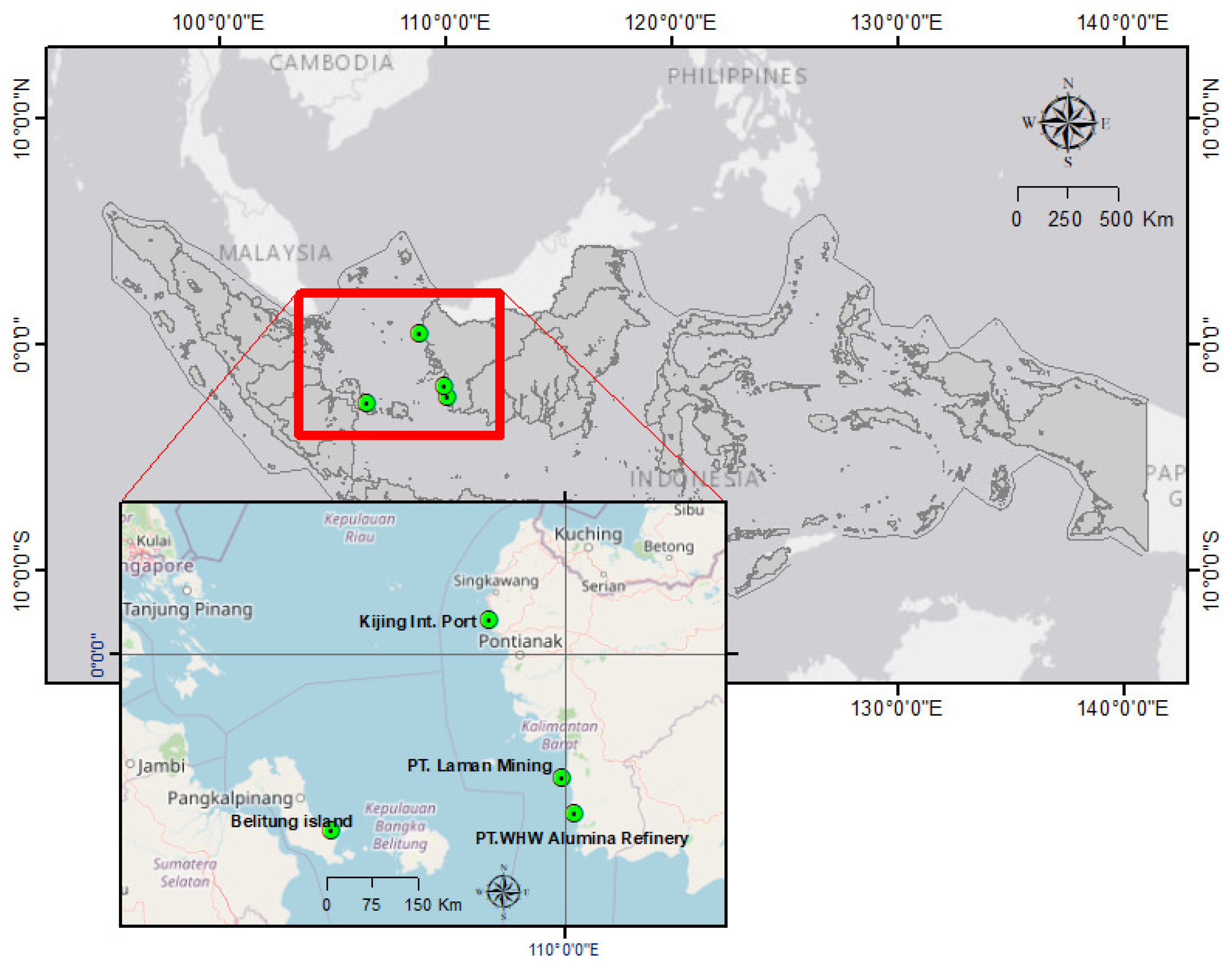
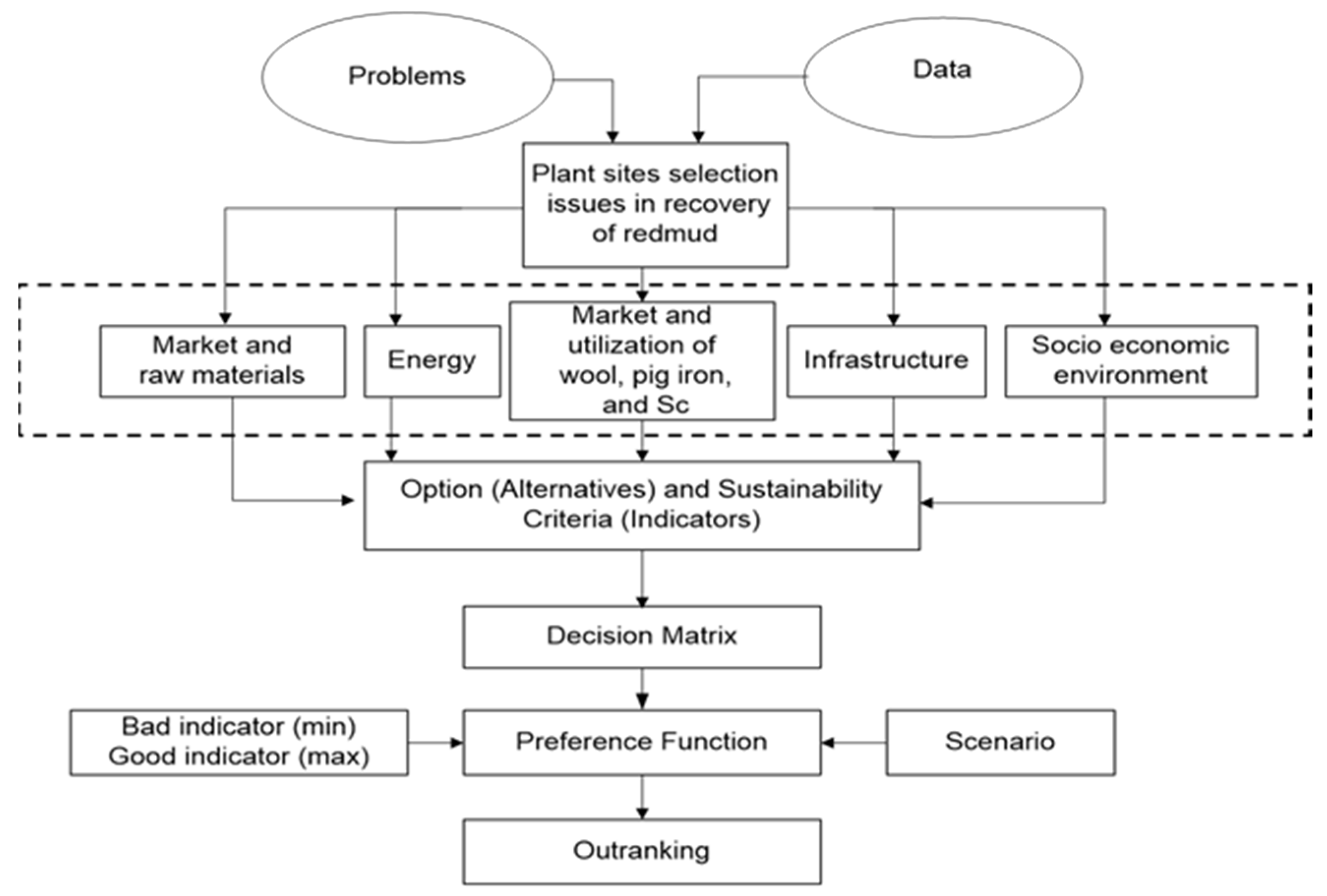
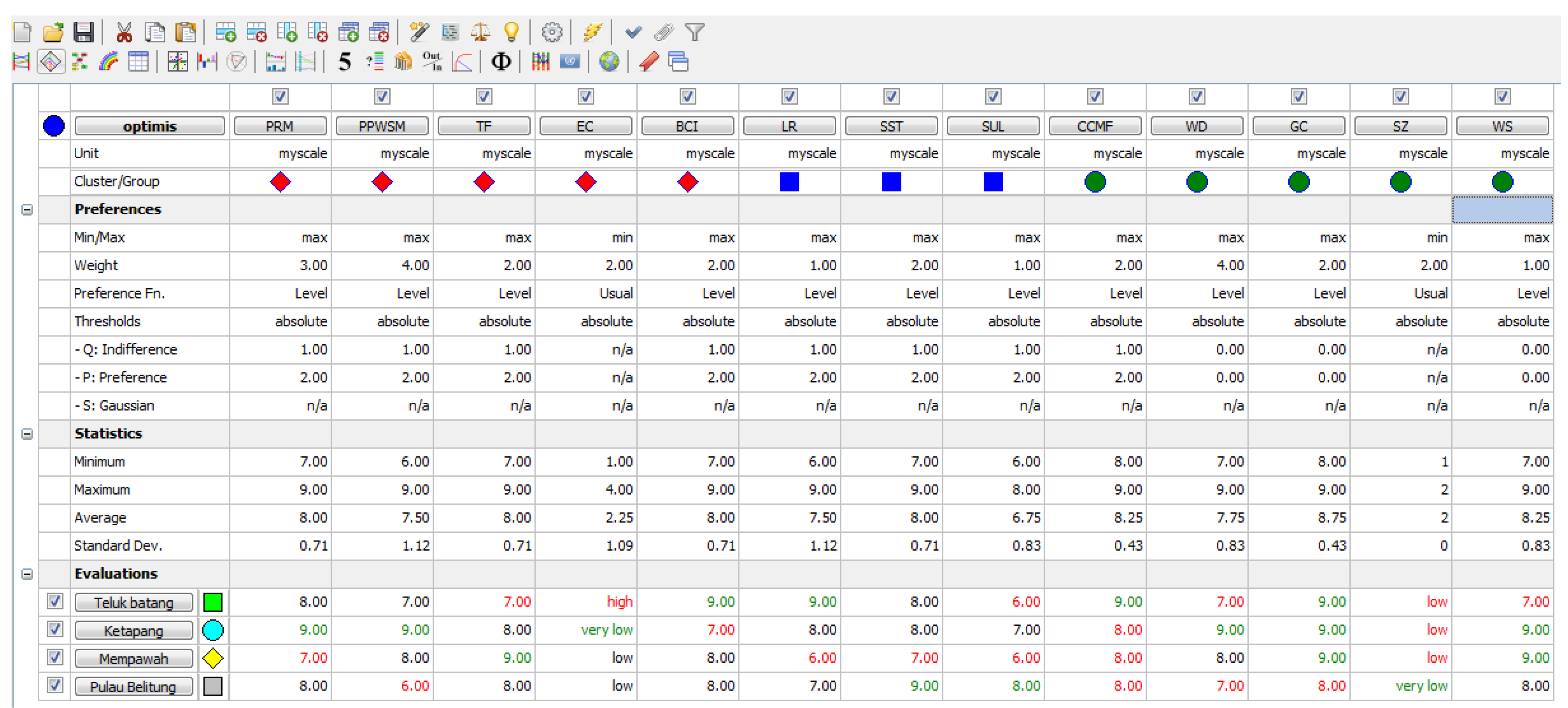
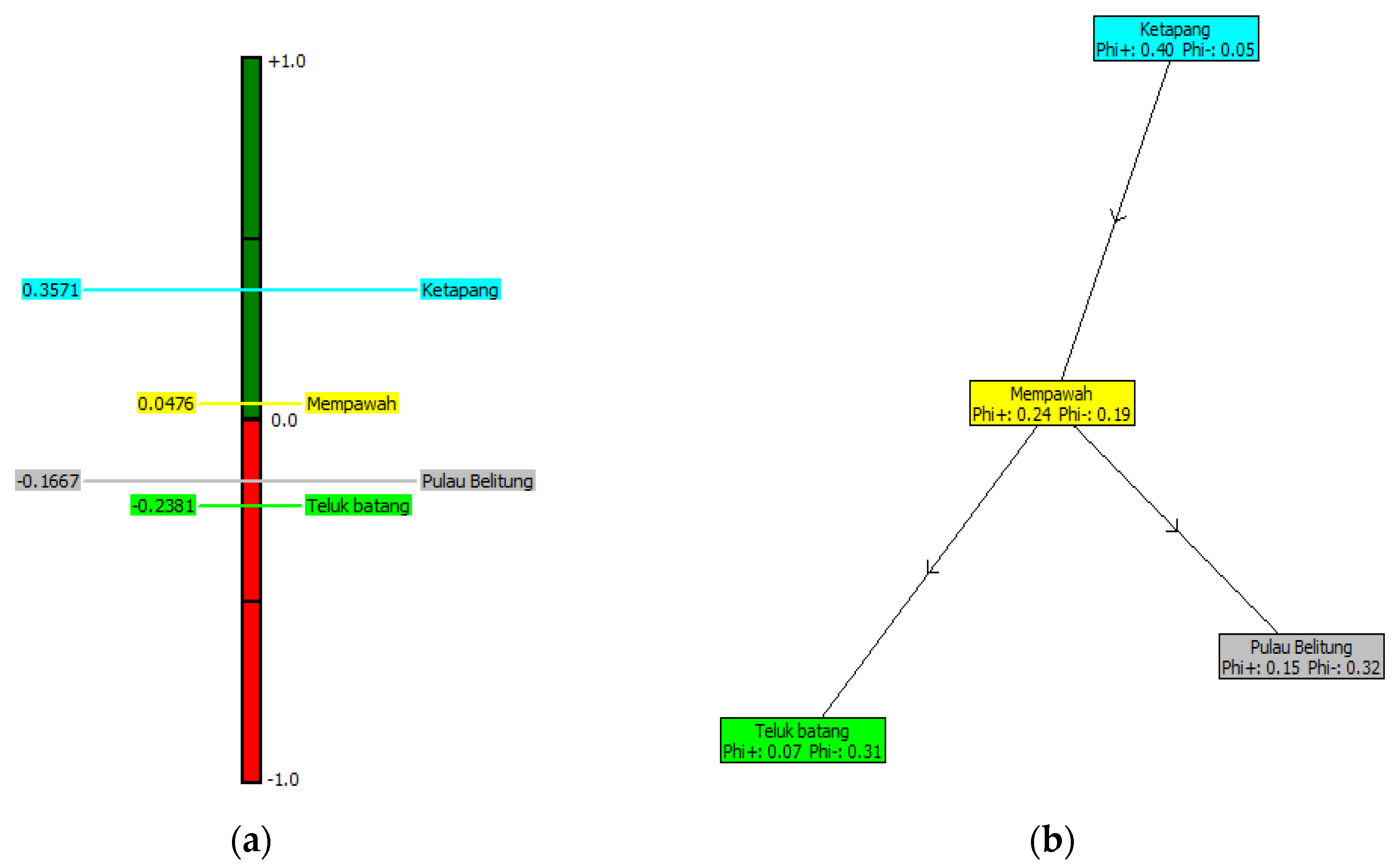
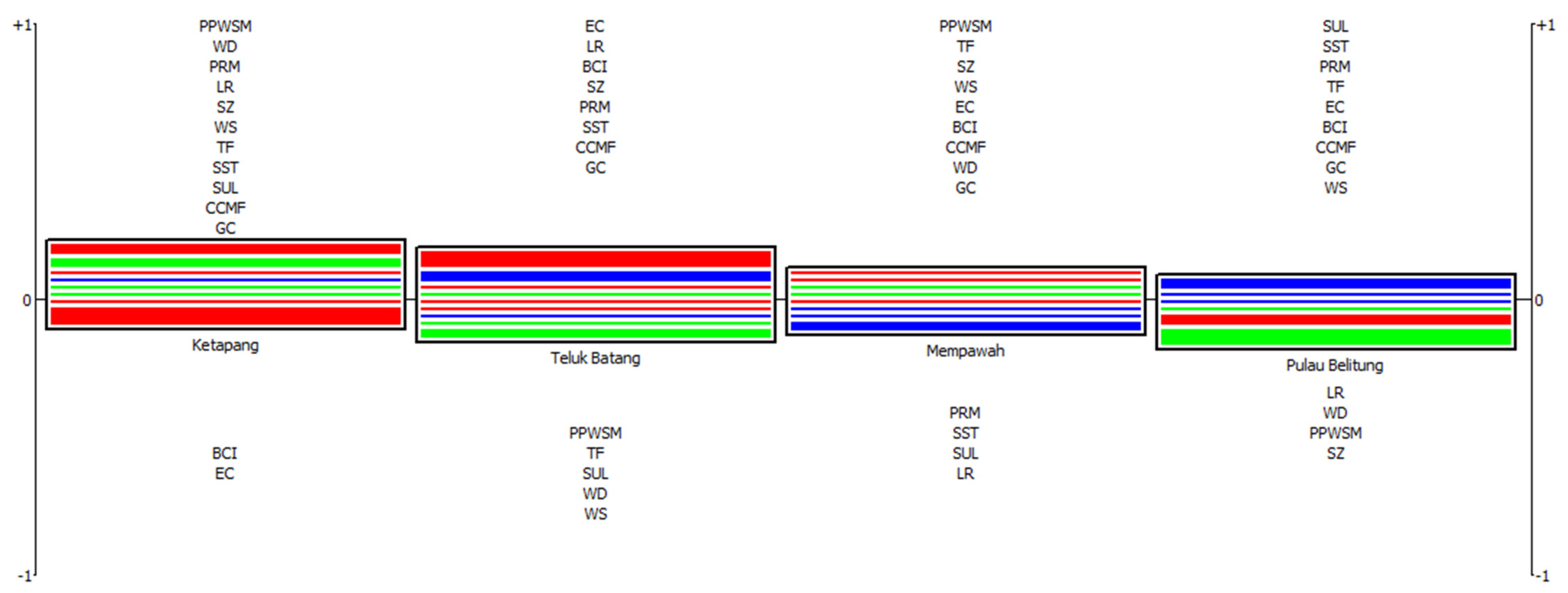
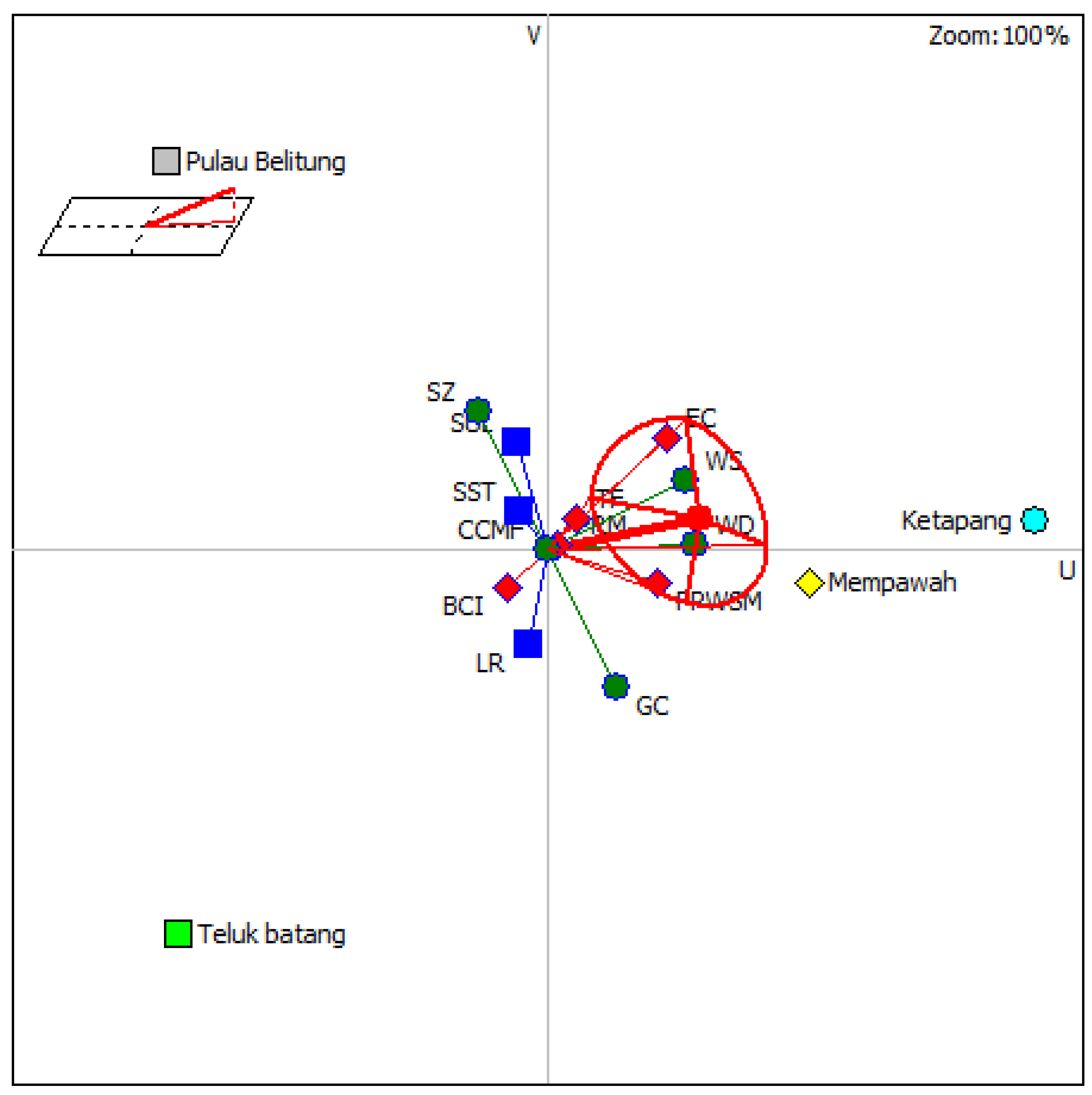


| Criteria | Min/Max | Type * | Preference Function | Weight * |
|---|---|---|---|---|
| Proximity to raw materials (PRM) | Max | Qualitativee | Level | 3 |
| Proximity to pig iron, wools, and scandium market (PPWSM) | Max | Qualitative | Level | 4 |
| Transport facilities (TF) | Max | Qualitative | Level | 2 |
| Communication, construction, and maintenance facilities (CCMF) | Max | Qualitative | Level | 2 |
| Skilled and unskilled labor (SUL) | Max | Qualitative | Level | 2 |
| Labor rate (LR) | Max | Qualitative | Level | 1 |
| Waste disposal (WD) | Max | Qualitative | Level | 2 |
| State-sponsored training (SST) | Max | Qualitative | Level | 1 |
| Water supply (WS) | Max | Qualitative | Level | 2 |
| Energy cost (EC) | Min | Qualitative | Usual | 4 |
| Building cost index (BCI) | Max | Qualitative | Level | 2 |
| General climate (GC) | Max | Qualitative | Level | 1 |
| Seismic zone (SZ) | Min | Qualitative | Usual | 2 |
Publisher’s Note: MDPI stays neutral with regard to jurisdictional claims in published maps and institutional affiliations. |
© 2022 by the authors. Licensee MDPI, Basel, Switzerland. This article is an open access article distributed under the terms and conditions of the Creative Commons Attribution (CC BY) license (https://creativecommons.org/licenses/by/4.0/).
Share and Cite
Hendrik; Yuan, Y.; Fauzi, A.; Widiatmaka; Suryaningtyas, D.T.; Firdiyono, F.; Yao, Y. Determination of the Red Mud Industrial Cluster Sites in Indonesia Based on Sustainability Aspect and Waste Management Analysis through PROMETHEE. Energies 2022, 15, 5435. https://doi.org/10.3390/en15155435
Hendrik, Yuan Y, Fauzi A, Widiatmaka, Suryaningtyas DT, Firdiyono F, Yao Y. Determination of the Red Mud Industrial Cluster Sites in Indonesia Based on Sustainability Aspect and Waste Management Analysis through PROMETHEE. Energies. 2022; 15(15):5435. https://doi.org/10.3390/en15155435
Chicago/Turabian StyleHendrik, Yin Yuan, Akhmad Fauzi, Widiatmaka, Dyah Tjahyandari Suryaningtyas, Florentinus Firdiyono, and Yang Yao. 2022. "Determination of the Red Mud Industrial Cluster Sites in Indonesia Based on Sustainability Aspect and Waste Management Analysis through PROMETHEE" Energies 15, no. 15: 5435. https://doi.org/10.3390/en15155435






